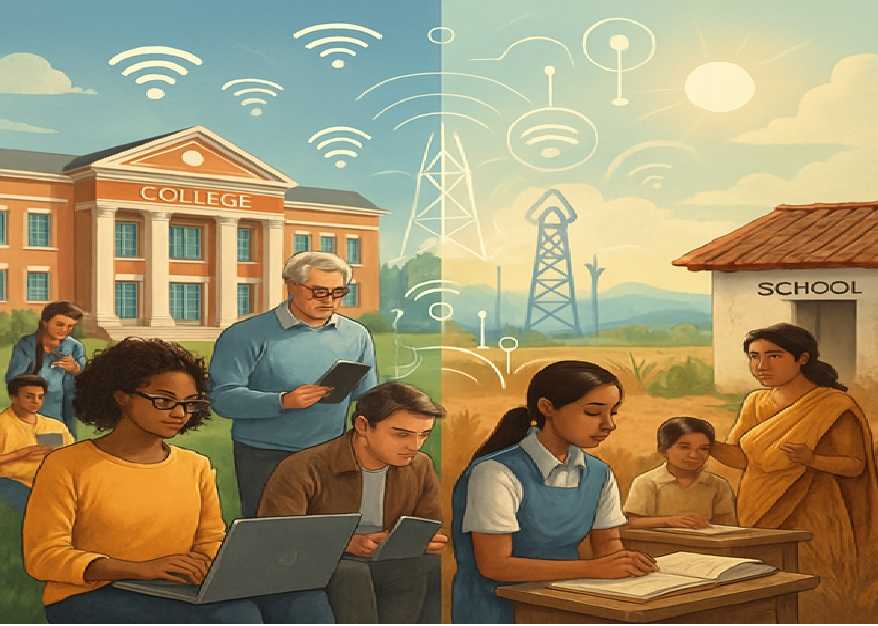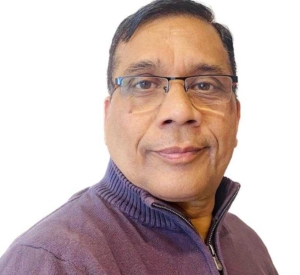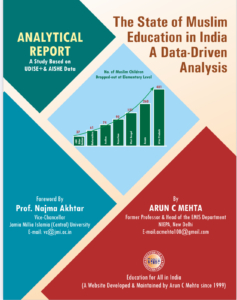
Can Digital India Bridge the Learning Divide in Colleges?
Abstract
The Digital India initiative, launched in 2015, aims to create a digitally empowered society by enhancing connectivity, digital literacy, and access to services. Higher education holds the potential to address disparities in access and quality, particularly the digital divide affecting rural and marginalized students. This article examines whether Digital India can bridge the learning divide in Indian colleges through the integration of Educational Technology (EdTech), including Artificial Intelligence (AI), Learning Management Systems (LMS), and Massive Open Online Courses (MOOCs) like SWAYAM. It reviews expenditure trends, policy gaps, digital infrastructure challenges, and faculty readiness, offering data-driven insights and recommendations to achieve equitable education by 2035, as envisioned by the National Education Policy (NEP) 2020.
Introduction
India’s higher education system, with over 1,362 universities and 52,538 colleges as of FY25, serves 43.3 million students, yet faces significant challenges in ensuring equitable access and quality. The digital divide—unequal access to technology and the internet—exacerbates disparities, particularly for rural and low-income students, with only 15% of Indian households having internet access and 8% owning computers. The COVID-19 pandemic exposed these gaps, as the shift to online learning left many students disconnected. With its pillars of digital infrastructure, literacy, and service delivery, the Digital India initiative seeks to address these issues. This article analyzes the initiative’s potential to bridge the learning divide in colleges through EdTech integration, focusing on AI, LMS, and MOOCs like SWAYAM, while highlighting policy gaps, infrastructure challenges, and faculty readiness. Expenditure trends are presented to contextualize investments, and recommendations are proposed to align with NEP 2020’s goal of a 50% Gross Enrolment Ratio (GER) by 2035.
Review of Digital India and EdTech Integration
The Digital Divide in Higher Education
The digital divide in India is a critical barrier to equitable education. Rural areas suffer from low broadband penetration (39% globally, lower in India) and unreliable electricity, limiting online and blended learning access. Gender disparities are notable, with only 21% of women versus 42% of men using mobile internet, driven by socio-economic and cultural factors. Urban colleges, such as those under AICTE (approx 8,902 institutes in 2022-23), have better digital infrastructure, but rural institutions lag, hindering access to quality education. The shift to online learning during the pandemic highlighted these disparities, with many students unable to participate due to a lack of devices or connectivity.
EdTech Integration: AI, LMS, and MOOCs
EdTech offers transformative potential for Indian colleges. Learning Management Systems (LMS) like Moodle or Blackboard enable centralized course delivery, assessments, and student engagement, supporting blended learning. Premier institutions like IITs and IIMs have adopted LMS effectively, but rural colleges face challenges due to limited infrastructure and faculty training. Artificial Intelligence (AI) enhances personalization through adaptive learning platforms and chatbots, tailoring content to individual student needs. For example, AI-driven tools can analyse student performance and recommend resources, improving outcomes. However, adoption is uneven, with urban institutions leading due to better resources.
Massive Open Online Courses (MOOCs), particularly SWAYAM, have expanded access to quality education. SWAYAM offers over 2,000 courses, with approx 1.5 crore students enrolled by 2020. Yet, only 4% of colleges in Telangana utilize SWAYAM, indicating underutilization. Challenges include language barriers (most courses are in English), lack of awareness, and limited digital access in rural areas. Despite these, SWAYAM’s credit recognition and affordability align with NEP 2020’s goals of flexibility and inclusivity.
Expenditure Trends in Education
Investment in education is critical for Digital India’s success. The Economic Survey 2022-23 reported that education expenditure increased from ₹3,91,881 crore in 2015-16 to ₹7,57,138 crore (budgeted) in 2022-23, a 93.21% rise, though its share of total social services expenditure declined from 10.4% to 9.5%. For 2024-25, the Department of School Education & Literacy received ₹73,498 crore, with significant allocations for Samagra Shiksha (₹37,010 crore). However, higher education’s share remains lower, and actual expenditure often falls short of budgeted amounts. Table 1 summarizes expenditure trends, and Figure 1 visualizes this data.
Table 1: Education Expenditure Trends in India (2015-16 to 2024-25) |
|||
|
Year |
Expenditure (₹ Crore) | % of Social Services Expenditure |
Source |
| 2015-16 | 3,91,881 | 10.4% | Economic Survey 2022-23 |
| 2020-21 | 5,47,239 | 9.8% | Economic Survey 2022-23 |
| 2021-22 | 6,43,409 | 9.7% | Economic Survey 2022-23 |
| 2022-23 | 7,57,138 (Budgeted) | 9.5% | Economic Survey 2022-23 |
| 2024-25 | 73,498 (School Ed.) | – | IBEF Report |
Policy Gaps and Challenges
Despite Digital India’s ambitions, several challenges persist:
- Digital Infrastructure: BharatNet aims to connect rural areas with high-speed broadband, but progress is slow, with only 5,90,020 Common Service Centres operational by 2023. Rural colleges struggle with unreliable internet and electricity, limiting EdTech adoption.
- Faculty Readiness: Many faculty lack digital literacy and pedagogical skills for online teaching. The pandemic exposed this gap, with limited training programs available. Only a fraction of colleges invest in faculty development for EdTech integration.
- Policy Implementation: Initiatives like PM eVidya and DIKSHA aim to unify digital education, but regional disparities and inadequate monitoring hinder impact. The DEIFDC index scores India at 0.596, citing infrastructure and pedagogical limitations.
- Equity and Inclusion: Marginalized groups, including Scheduled Castes, Tribes, and Muslims, face additional barriers. The State of Muslim Education in India report highlights lower GER among Muslim students (2021-22 data) – gender disparities further limit access for women.
Concluding Observations
Digital India holds significant promise to bridge the learning divide in Indian colleges by leveraging AI, LMS, and MOOCs like SWAYAM. However, the digital divide, inadequate infrastructure, and faculty unpreparedness pose formidable challenges. Expenditure trends show increased investment, but higher education requires a larger share to support digital initiatives. NEP 2020’s vision of a 50% GER by 2035 demands urgent action to address these gaps.
Recommendations
- Accelerate Infrastructure Development: Expand BharatNet and ensure affordable devices and reliable electricity in rural colleges.
- Enhance Faculty Training: Implement mandatory, scalable programs to build digital pedagogy skills.
- Promote Inclusive EdTech: Develop regional-language MOOCs and accessible platforms for disabled students.
- Strengthen Policy Monitoring: Establish robust oversight mechanisms to address regional disparities.
- Address Gender and Social Gaps: Expand initiatives like Internet Saathi to boost digital access for women and marginalized groups.
By addressing these challenges, Digital India can transform higher education, ensuring equitable access and quality learning for all students, aligning with NEP 2020’s transformative vision.
Suggested Readings
- Economic Survey 2022-23. (2023). Ministry of Finance, Government of India.
- Education in India. (2025). Wikipedia.
- Higher Education in India: Trends & Index. (2025). India Brand Equity Foundation.
- Mehta, A. C. (2023). The State of Muslim Education in India: A Data-Driven Analysis. Education for All in India.
- Acilar, A., & Sæbø, Ø. (2023). Towards understanding the gender digital divide: A systematic literature review. Education and Information Technologies.
- UNESCO. (2021). Global Education Monitoring Report.
- Kanjilal, U., & Kaul, P. (2016). SWAYAM: The platform for MOOCs in India. Education and Information Technologies.
Published on Education for All in India | © 2025


